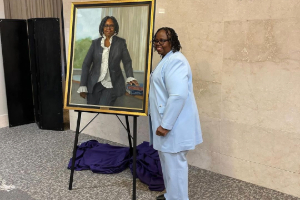Pathway to Feinberg: Tacoma McKnight, ’81 BS, ’83 MD (HPME), ’87 GME

"A Northwestern legacy of empowerment"
Growing up on Chicago’s south side, Tacoma McKnight, ’81 BS, ’83 MD (HPME), ’87 GME witnessed firsthand the challenges her father faced in accessing medical care. “I was driven to become a doctor so I could care for my father,” she said, a motivation rooted in a desire to bridge healthcare gaps where systemic barriers often hindered access to quality care. She holds a historic honor at Northwestern University as the second Black female Obstetrics & Gynecology resident at Prentice Women's Hospital, the first Black female faculty member at Northwestern University Feinberg School of Medicine, and later served as inaugural associate dean for the Office of Diversity and Inclusion (formerly known as the Minority and Cultural Affairs office).
Inspiration for a career in Medicine:
“As a child in school, when asked what I wanted to be, I always said I wanted to be a doctor, which often surprised teachers. Many of them, usually from the majority, would respond skeptically, questioning the difficulty of achieving that goal. Their doubts only fueled my determination to prove them wrong. This drive stemmed from wanting to provide healthcare not just for my family but also because it was evident that the healthcare system wasn’t welcoming or accessible for people of color. Despite its challenges, I chose to stay at Northwestern because I found a nurturing environment there. While the institution had a reputation for not being inclusive, I encountered colleagues committed to improving diversity and inclusivity. There was a shared desire to change the hospital's reputation and make it a more welcoming place for everyone, especially people of color. This dedication to progress and the potential to contribute positively to change were key reasons why I remained there.”
Memorable moments at Feinberg:
One stand-out moment from McKnight’s time at Feinberg was getting the Minority and Cultural Affairs office established. She recalled that “the students were the driving force behind advocating for representation. They noticed the lack of diversity in key committees, curriculum development, and student advocacy groups. This lack of representation meant that their perspectives and concerns were often overlooked or ignored. It was the students who grew tired of constantly having to prove themselves. They wanted administrative support, especially in situations where teachers, physicians, scientists, and clinicians were overtly racist through their words and actions. This created a sense of what I term as ‘benign neglect,’ where no actions were taken to hold someone back, but there was also no effort to help them move forward. Both scenarios posed significant issues.”
Early efforts began with students bringing their issues to Dr. Dennis Perry, an African American with a Ph.D. in microbiology, who acted as a minority advisor. These discussions evolved into organized meetings where students strategized on how to address systemic issues they faced within the institution. The momentum grew as more students voiced their concerns and sought solutions collectively.
As the need for dedicated support became apparent, discussions progressed from mere talks about a minority affairs office to establishing a full-fledged Minority and Cultural Affairs Office with designated leadership roles. The urgency from top-level mandates propelled institutions like Northwestern University to act swiftly and decisively, particularly in creating pathways for underrepresented groups in medicine.
“The push for diversity extended beyond student representation to addressing admissions practices. There was a realization that simply having a pool of applicants wasn’t enough; active efforts were needed to attract and retain diverse talent. The mindset shifted from passively selecting from a pool to actively cultivating a diverse applicant pool. This grassroots movement gained traction over time and efforts intensified when the Association of American Medical Colleges launched the 3000 by 2000 program committed to increasing minority representation in medical schools. They set ambitious goals, challenging medical schools to develop concrete plans for diversity initiatives,” she reflects.
Another key highlight at Feinberg was the establishment of the first-ever pathway programs. “My journey towards medicine began with various programs offered in the Chicago public school system and the city itself. In high school, I was accepted into a program aimed at introducing minority students to healthcare careers. This program exposed me to hospitals, different medical specialties, and the realities of medical practice. My time at Cook County Hospital's Obstetrics & Gynecology department during this program solidified my desire to pursue medicine.”
Advice for Young Mentees:
“You’ve got to allow yourself grace. You are not perfect, you are not a perfect automaton. When you find obstacles, understand that there is help. Ask for it. Look for alliances. Always remember there's likely another way around the obstacle, so look for what else you can do.”
The Importance of Diversity and Inclusion:
McKnight views DEI as activism. “For me, it creates an active, actionable set of criteria. You now have a lens to ask, "Is it diverse? Is it inclusive? Does it promote equity among those involved?" You can apply it to physicians, nurses, or any healthcare arena. DEI pushes us to keep looking at everything and ensures everyone feels that they belong and are valued. That's also why it's important because we must never forget to evaluate everything through the lens of diversity, equity, and inclusiveness. There is space for everyone.”
Bonus Tip: Staying Informed
Even though she retired last year, McKnight remains a part of the American College of Obstetrics and Gynecology. She receives newsletters, updates, committee opinions, and other resources from organizations such as the FDA, Illinois Department of Health, New York Times and maintains her membership with the American Board of Obstetrics and Gynecology, which requires her to read a specific number of articles each year. “It’s a variety of things you have to do to stay informed. I also attend various conferences and grand rounds offered by the Department of Obstetrics and Gynecology,” she said.